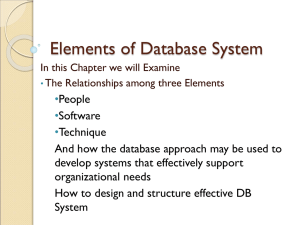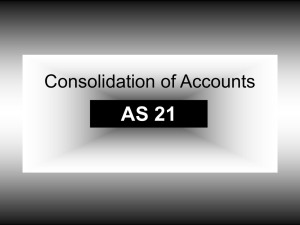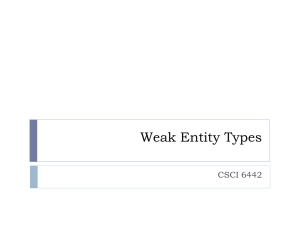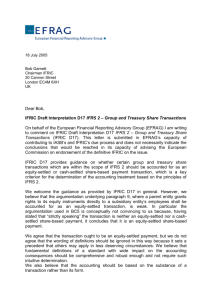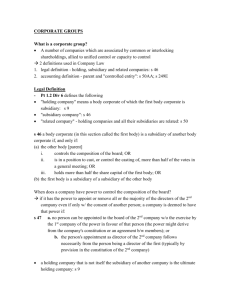Consolidation Issuesin IFRS
advertisement
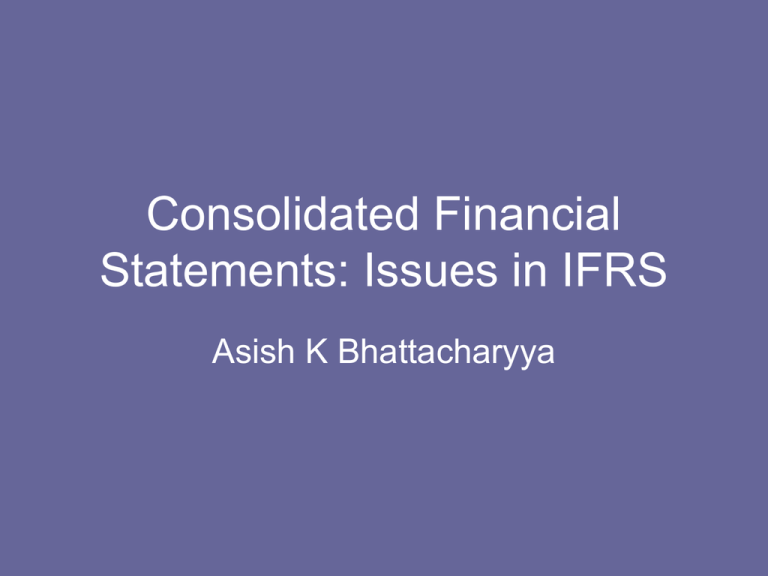
Consolidated Financial Statements: Issues in IFRS Asish K Bhattacharyya Measurement Of Subsidiary’s Assets and Liabilities At Fair Value • IFRS-3 has adopted the entity theory in stipulating accounting principles and methods for combining the financial statements of a parent and its subsidiaries. • The entity theory views the parent and subsidiary as a single entity. • Accordingly, all the assets and liabilities of the subsidiary and any goodwill are reflected in the consolidated balance sheet at their full fair values on the date of combination, regardless of the actual percentage of ownership acquired. 13-04-2015 2 Measurement Of Subsidiary’s Assets and Liabilities At Fair Value • Therefore, the first step in the preparation of consolidated financial statements is to restate the assets and liabilities notionally in the subsidiary’s balance sheet on the date of acquisition at their fair value. • The next step is to prepare consolidated financial statements. • The consolidation procedure stipulated in IAS-27 is substantially same as that in AS-21. 13-04-2015 3 Negative Goodwill • If the parent’s share in the net fair value of subsidiary’s assets and liabilities at the date of acquisition exceeds the parent’s cost of acquisition, the excess is often described as ‘negative goodwill’. • IFRS-3 requires that the negative goodwill should be recognized in the profit and loss account. 13-04-2015 4 Negative Goodwill • Therefore, in preparing consolidated financial statements immediately after the parentsubsidiary relationship is established, the negative goodwill should be recognized in the consolidated profit and loss account. • The negative goodwill (income in the bargain purchase) belongs to the parent. • Therefore, it should not be considered in allocating subsidiary’s profit or loss to the minority interest. 13-04-2015 5 Minority Interest • IFRS -3 requires that minority interest should be presented in the balance sheet within equity, separate from the parent shareholders’ equity. • The accounting principle is based on the fact that a minority interest is not a liability of the group; rather, it represents the residual interest in the net asset of the subsidiary by some of the shareholders of the subsidiary. 13-04-2015 6 Potential Voting Rights • IFRS -3 stipulates that in order to assess whether one entity has control over another, the existence and effect of potential voting rights that are currently exercisable or convertible should be considered. • In consolidating financial statements of a parent and its subsidiary, the proportions of profit or loss and changes in equity allocated to the parent and minority interests are determined based on the present ownership interests and do not reflect the possible exercise or conversion of potential voting rights. 13-04-2015 7 Variable Interest Entities • Commonly, SPEs are set up as trusts or partnerships with very little equity participation. • Equity investors in an SPE usually do not bear the residual economic risks. • Therefore, it is not appropriate to determine control over the financial and operating decisions of an SPE based on equity voting rights of different entities. 13-04-2015 8 Variable Interest Entities • Moreover, some types of SPEs are controlled through some arrangements other than voting interests. • As a result, these SPEs are outside the purview of ARB-51, which has taken the voting interest approach in determining whether an enterprise has a controlling financial interest in another entity. • FASBI-46 brings within the purview of ARB-51 an SPE in which an enterprise has a controlling financial interest although it does not hold a majority voting interest. 13-04-2015 9 Variable Interest Entities • An entity that is the primary beneficiary of a VIE must present consolidated financial statements by consolidating the VIE’s financial statements with its own. 13-04-2015 10 Variable Interest Entities: Definition • FASBI-46 covers those VIEs which have one or both of the following characteristics: 1. The equity investment at risk is not sufficient to permit the entity to finance its activities without additional subordinated financial support from other parties 13-04-2015 11 Variable Interest Entities: Definition • 2. As a group, the holders of the equity investment at risk lack any one of these three characteristics of a controlling financial interest: (a) The direct or indirect ability to make decisions about the entity’s activities through voting or similar rights ( b) The obligation to absorb the expected losses of the entity if they occur, which makes it possible for the entity to finance its activities (c) The right to receive the expected residual returns of the entity if they occur, which is the compensation for the risk of absorbing the expected losses 13-04-2015 12 Variable Interest Entities: Definition • ‘Subordinated financial support’ refers to variable interests that will absorb some or all of an entity’s expected losses if they occur. 13-04-2015 13 Primary Beneficiary • The primary beneficiary of a VIE is an entity that absorbs a majority of the VIE’s expected losses, receives a majority of its expected return or both, as a result of holding variable interests (i.e. ownership, contractual, or other pecuniary interests). • An entity having a variable interest in a VIE should determine at the time it becomes involved with the entity whether or not it is the primary beneficiary of the entity. 13-04-2015 14


